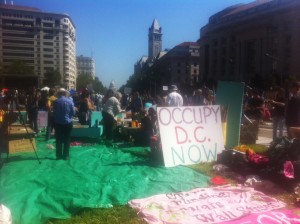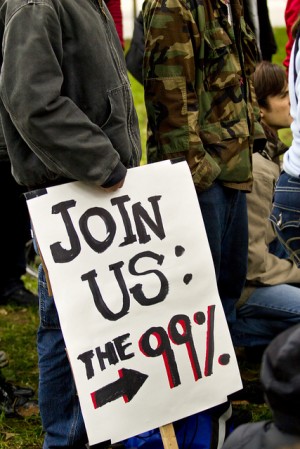Occupy Protests: Are They Representative?
The Occupy Wall Street protests have spread to other cities, including the District. Protesters are are calling for an end to corporate greed and proclaiming the vast majority of Americans suffer while the rich haven’t.
More than a hundred people gathered at Freedom Plaza on Thursday, some wielding signs with statement like “We are the 99%.”
It would make sense that such a movement would have particular relevance for communities of color, who are facing higher unemployment rates and are largely on the losing side of the wealth gap. So some have wondered why the crowds in some cities have been mostly white.
Racialicious compiled a number of dispatches from activist reporting many people of color are absent from leadership positions or feel marginalized at the New York protests. Such rumblings helped spur the formation of “The People of Color Working Group,” which issued a statement:
… The economic crisis did not begin with the collapse of the Lehman Brothers in 2008. Indeed, people of color and poor people have been in a state of crisis since the founding of this country, and for indigenous communities, since before the founding of the nation. We have long known that capitalism serves only the interests of a tiny, mostly white, minority.
The vast majority of the crowd at Occupy DC’s Thursday protest was white, but a number of people of color said they felt speakers’ messages and the crowd assembled was representative of those who are suffering.
“If one person is affected, the globe is affected,” Simone Evans-Blango of D.C. said. “I think [focusing on] who is affected by what is counterproductive and divisive.”
Jerri Walker, a Howard University student, said she was pleased with the diversity of the crowd. And Shari Whitaker of Maryland said, “we’re all hurting. No one race is hurting more than the other.”

Elahe Izadi / DCentric
A crowd gathered on Freedom Plaza on Thursday. Most, but not all, protestors were white.
Some white activists, however, said the crowd was disproportionately white. Some questioned whether the fear of facing law enforcement could have dissuaded people of color from attending. There have been reports of clashes with police at the New York protests.
“It’s one of the privileges of being white, especially a female,” Sarah Eyre of Baltimore said. “If something happens to you, it probably won’t be as bad than if you were not white.”
White activists also said better outreach was needed.
“What we’ve seen today is a start,” Kathleen Sutcliffe of D.C. said. “If this isn’t diverse enough then we need to make the effort to reach out and form coalitions. It needs to be the entire 99 percent.”
Dwight Kirk of the Coalition of Black Trade Unionists said there needed to be greater diversity, but he was optimistic that such gaps could be bridged, particularly with the use of social media. The effort needs to be a conscious one, he added.
“There needs to be an awareness that we’re not all coming to the table equally empowered,” he said.
Some activists in New York have already made noise about it. An “Open Letter From Two White Men to #OCCUPYWALLSTREET” was written in response to reports of marginalization at the New York protests:
… We would like to add our voices to the chorus of constructive critiques coming from communities of color. We believe the white people of #OccupyWallStreet need to understand something: the feelings of economic insecurity, political powerlessness, and lack of support that have brought so many of us to the protests at Liberty Park have been lived by many of the people of color in this country for centuries. Without an active effort to address racial issues from the core of #OccupyWallStreet, the protest will fail…
The reality is that organizing a protest in the middle of a weekday prevents a lot of people from participating. It particularly shuts out the working poor who, regardless of race, cannot afford to take a day off from work — even if it’s to protest against a system they feel has by-and-large failed them.
-
Anonymous







